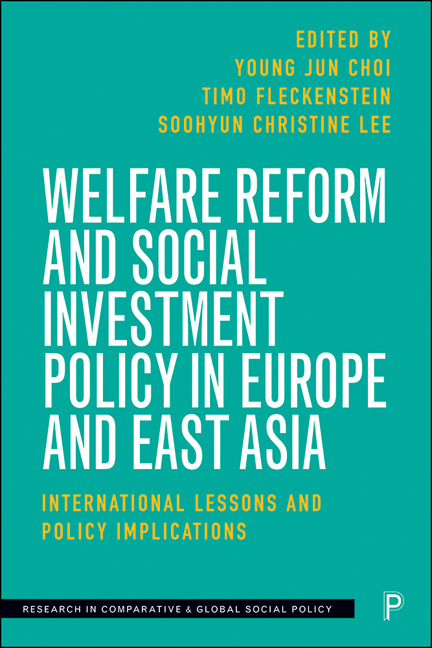 Welfare Reform and Social Investment Policy in Europe and East Asia
Welfare Reform and Social Investment Policy in Europe and East Asia Book contents
- Frontmatter
- Contents
- List of figures and tables
- Notes on contributors
- Acknowledgements
- Preface from the series editors
- 1 Introduction: social investments and welfare reform in Europe and East Asia
- 2 Work–family policy expansion and the idea of social investment: the cases of Germany, England, South Korea and Japan
- 3 Private education in South Korea: lessons for the West from past mistakes?
- 4 How do family background and shadow education affect academic performance and labour market outcomes in South Korea? Reasons for redistributive social investment
- 5 Employability, higher education and the knowledge economy
- 6 Does social investment make the labour market ‘flow’? Family policies and institutional complementarities in Italy, Spain, Japan and South Korea
- 7 The social investment approach and gender division of housework across East Asia and Europe
- 8 Employment outcomes of social investment in latecomer countries
- 9 Estimation of the human capital depreciation rate: an international comparison and policy implications in South Korea
- 10 Changing patterns of grandparenting and their implications for active ageing in England and South Korea
- 11 The governance of social investment policies in comparative perspective: long-term care in England and South Korea
- 12 Towards greater social investments and equality in Europe and East Asia: policies and politics
- Index
9 - Estimation of the human capital depreciation rate: an international comparison and policy implications in South Korea
Published online by Cambridge University Press: 21 December 2021
- Frontmatter
- Contents
- List of figures and tables
- Notes on contributors
- Acknowledgements
- Preface from the series editors
- 1 Introduction: social investments and welfare reform in Europe and East Asia
- 2 Work–family policy expansion and the idea of social investment: the cases of Germany, England, South Korea and Japan
- 3 Private education in South Korea: lessons for the West from past mistakes?
- 4 How do family background and shadow education affect academic performance and labour market outcomes in South Korea? Reasons for redistributive social investment
- 5 Employability, higher education and the knowledge economy
- 6 Does social investment make the labour market ‘flow’? Family policies and institutional complementarities in Italy, Spain, Japan and South Korea
- 7 The social investment approach and gender division of housework across East Asia and Europe
- 8 Employment outcomes of social investment in latecomer countries
- 9 Estimation of the human capital depreciation rate: an international comparison and policy implications in South Korea
- 10 Changing patterns of grandparenting and their implications for active ageing in England and South Korea
- 11 The governance of social investment policies in comparative perspective: long-term care in England and South Korea
- 12 Towards greater social investments and equality in Europe and East Asia: policies and politics
- Index
Summary
Introduction
Not only does an individual's human capital determine their wages, living standards and quality of life, it is also closely related to productivity, growth and employment at the national level. It plays a significant role in integrating society as well. Despite the considerable effort and political interest in amassing and improving human capital, however, research on how accumulated human capital is maintained or depreciated remains scant. In particular, the importance of estimating the human capital depreciation rate as a starting point for research on human capital depreciation has generally been overlooked, except for the works of Mincer and Polachek (1974), Mincer and Ofek (1982), Carliner (1982), Neuman and Weiss (1995), and Albrecht et al (1999).
Although it is theoretically plausible to consider a human capital depreciation rate, the fact that a variety of factors such as physical ageing, unemployment and technological change affect the depreciation of human capital has led to this scarcity of empirical studies. Neuman and Weiss (1995) differentiated the depreciation of human capital into internal and external depreciation. The former indicates depreciation caused by individual-related reasons, including any loss of physical or mental ability. The latter occurs when the stock of knowledge obtained by learning gradually becomes obsolete owing to environmental changes, corresponding to the so-called vintage effects that Becker (1964) suggested.
However, Rosen (1975), and Weiss and Lillard (1978) argued that distinguishing between these two depreciation factors is impossible since they occur at the same time. As previous studies used wages as dependent variables in estimating the depreciation rate of human capital, both internal and external depreciation were reflected simultaneously in the changes in wages. Groot (1998), and Arrazola and Hevia (2004), who took different approaches, proposed non-linear models that estimated the human capital depreciation rate directly. Specifically, both estimated the depreciation rate of human capital accumulated through formal education by using data collected from the UK and from the Netherlands and Spain, respectively. However, they also estimated the depreciation rate of human capital by using wage data; their estimation of the depreciation rate accordingly reflected internal and external depreciation simultaneously. Due to the limitations of estimation, they could not provide clearer explanations on which of two factors – reduced physical or mental ability and the vintage effects – led to individual wage changes.
- Type
- Chapter
- Information
- Welfare Reform and Social Investment Policy in Europe and East AsiaInternational Lessons and Policy Implications, pp. 213 - 264Publisher: Bristol University PressPrint publication year: 2021


